-
TrimHSE
-
EngineTwo Electric Motors
-
Power394 HP / 512 LB-FT
-
TransmissionSingle Speed
-
0-60 Time4.5 Seconds
-
Top Speed124 MPH
-
DrivetrainAWD
-
Seating2 + 3
-
Cargo25.3 Cu-Ft
-
MPG75 MPGe
-
Base Price$71,050
-
As Tested Price$73,095
A legion of new electric cars has been launched over the past couple years, so it’s easy to forget about one of the earliest entries in the electric revolution: the Jaguar I-Pace. In fact, the I-Pace is so old now that it’s getting a mid-cycle refresh of sorts for the 2022 model year. Autoblog had its “First Drive” of this futuristic-looking crossover-hatchback nearly four years ago, so it’s time to see where the electric Jag stands now that it has more competition.
To really get a sense of where the I-Pace fits today, I decided to take it on a road trip from Detroit, Michigan, to Buffalo, New York, and back. This would test the car’s real-world highway range, its charging ability and luxury prowess as a premium crossover. It also ended up being a test of the Rust Belt’s charging infrastructure and ability to facilitate EV road tripping.
The trip starts with a 100% charge in Michigan, 50-degree weather and a 381-mile drive ahead of me. According to the sticker for this 2022 Jaguar I-Pace EV400 HSE, it has a 222-mile range on a full charge — that’s down from the 234 miles it was rated for in 2021. I set out, and it’s all good vibes at the start. This I-Pace has the standard 20-inch wheels (not the optional, giant 22s), which pair perfectly with the air suspension to provide a truly comfy ride. The adaptive cruise control makes dealing with rush-hour traffic through Detroit easy, and the I-Pace’s dual-motor powertrain, good for 394 horsepower and 516 pound-feet of torque, is a delight to unleash when the road opens up. Even at 60 mph-plus, the I-Pace has plenty of go to pin you back like other quick EVs do today.
As I make my way into Ohio and navigate through Toledo, some gripes pop up. The lane-centering system is finicky and downright scary at times. Poor lane markings cause it to abruptly yank the car left or right, and you need to be quick at the wheel to keep it from driving onto the shoulder or worse — other cars with similar lane-following tech perform significantly better on the same roads. It’s even more frustrating when I learn how good it is on a highway with clear and proper lane markings, tracking beautifully … until the road no longer cooperates. Its inability to cope when lane markings suddenly deteriorate makes this system hardly worth using. Watching out for its bad behavior is more mentally taxing than just turning the system off and driving without.
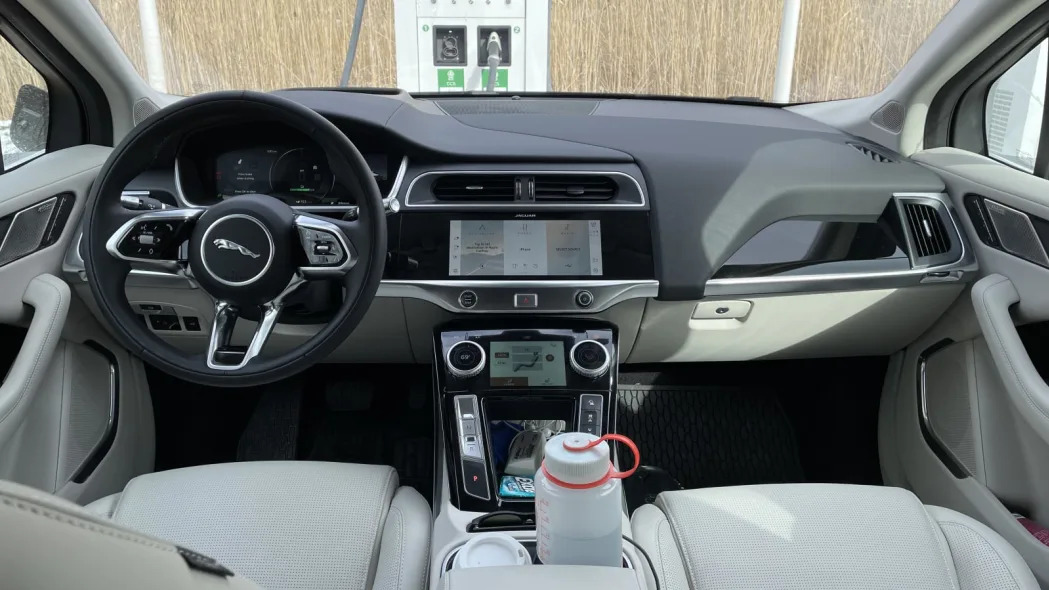
Another gripe: Before setting out, I tried to use Jaguar’s new charge stop planner in the new-for-2022 Pivi Pro infotainment system. It’s scads better than the old Jaguar setup the I-Pace originally had, but its ability to plan a road trip automatically for you around charging needs is not ready for primetime. After plugging in my destination, it took a good 30 seconds to identify charging stops, then spit out a 9-hour drive time. I nearly did a spit take across the windshield. A trip from Detroit to Buffalo in a gasoline engine-powered car takes about 6 hours, including gas and restroom stops.
As an alternative, I mapped out a route in the regularly reliable PlugShare app and quickly found that the circuitous route the I-Pace had concocted made very little sense. It clearly was not aware of many chargers located directly off major highways, including multiple Electrify America stations with very fast charging capability (beyond the speeds at which the I-Pace is actually capable of), resulting in large detours to the chargers it did know existed.
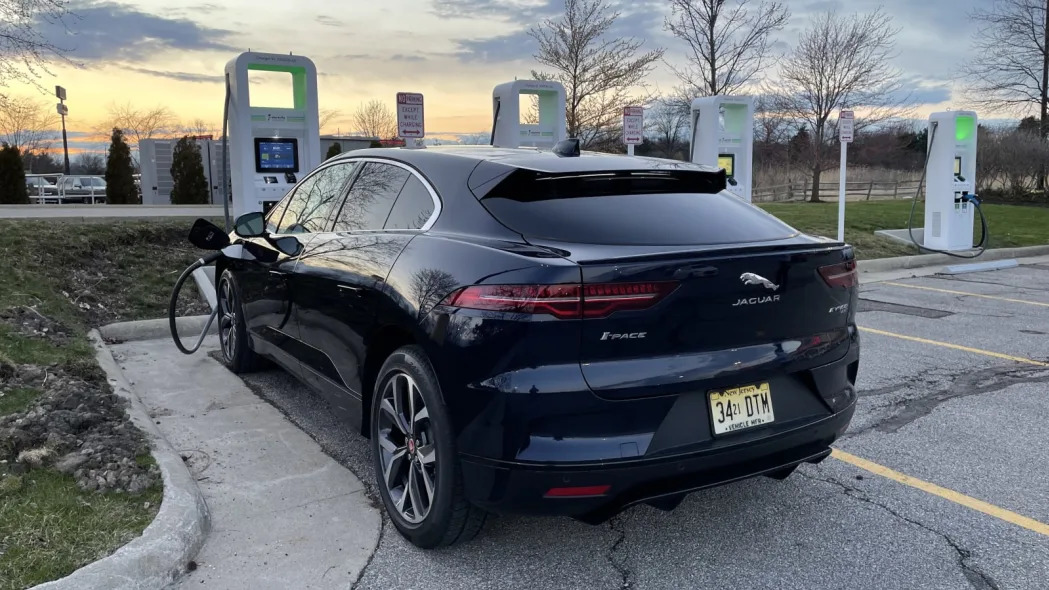
After 156 miles, I’m at my first stop. It’s an Electrify America station (the first of many) rated for 150 kilowatt fast charging, just west of Cleveland, Ohio. The I-Pace reads 20% charge, making it an ideal time to see how quickly the Jag can go from 20% on upwards at its peak charge speed of approximately 100 kW. I use the charge stop to get some dinner at a nearby pizza restaurant — not all charge stations have such conveniences. I unplug 1 hour and 6 minutes later. The I-Pace reads 97% charge, and I was $34.35 poorer. Not exactly cheap for energy that will effectively take me about 170 miles in ideal conditions – in fact, that’s only a few bucks cheaper than what the EPA says it’ll cost to drive the gas-powered, 22-mpg Jaguar F-Pace P340. This would be why it’s best to recharge at home, but at least the Electrify America station worked flawlessly, which is not a given. That includes seeing charging rates around the I-Pace’s 100-kW peak charging speed for a long while before it slowed down as the battery reached a higher state of charge.
My next stop is 120 miles away at a Walmart in Erie, Pennsylvania. I roll in with a still-healthy 34% charge and with just 104 miles to my destination from here, all I need is a quick burst of electrons before the final stretch. Unfortunately, the Walmart is closing up shop as I pull in, so I spend this charge waiting around in the far-flung reaches of a deserted parking lot — this is EV road trip charging reality, more often than not. After 37 minutes and $11.86 spent, I’m back on the road with a 78% charge. Once again, the Electrify America charger worked flawlessly, but not all were working at this charger location – again, something we’ve noticed elsewhere in the Electrify America network.




The road trip to Buffalo ends uneventfully just 104 miles later, with 28% charge left. It’s cold by this time, as the temperature slowly made its way into the low 40-degree range, sapping overall range all the while. It’s hard to imagine this trip going much smoother with an I-Pace, as the overall trip time was just 7.5 hours, and I got a nice dinner in the middle of it.
Would a car with far more range and significantly faster charging have been a better companion? Absolutely. The I-Pace is basically behind the times in every key EV factor. It has less range, partly because it’s one of the least efficient EVs at 75 mpg-e, and is slower to recharge. Cars that boast 800-volt electric architectures, including the Kia EV6, Hyundai Ioniq 5, Porsche Taycan and Audi E-Tron GT, can do the 20-80% charge sprint in about 20 minutes when taking advantage of available 350-kW fast chargers. By contrast, the I-Pace requires over twice that amount of time and can’t actually max out a 150-kW fast charger.
Having said all that, let’s take a moment to remember that there’s a lot more to cars than their range, efficiency and time to refuel. Because even if other cars ace it at an Electrify America station, the I-Pace is still a hoot everywhere else. Its combination of low center of gravity, 50:50 weight distribution and all-wheel-drive gives it shocking agility, and its brake-based torque vectoring is just enough of a help to make sure you’re using the power effectively. Even if you’re just swinging it through highway on-ramps as I was, it’s clear that it’s just as legitimately fun to throw around as it was when new back in 2019. All those new competitors don’t change that – the Jaguar I-Pace remains one of the best EVs for those who love to drive, ranking closer to a Taycan on the fun-to-drive scale than it does a Kia EV6. And it should, given the price tag.
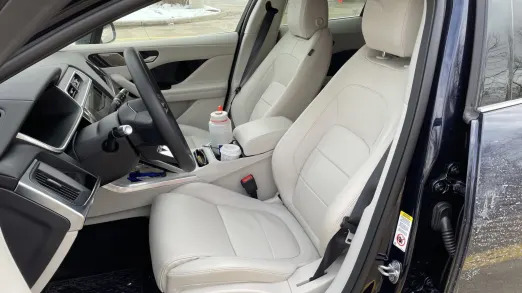
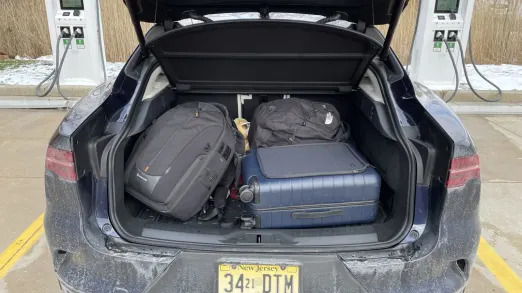
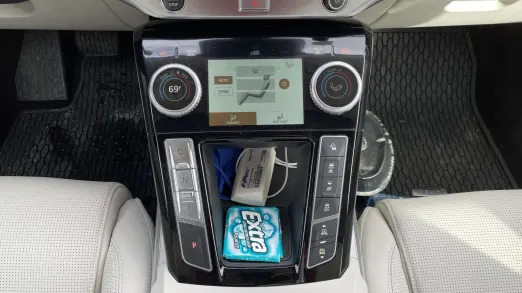
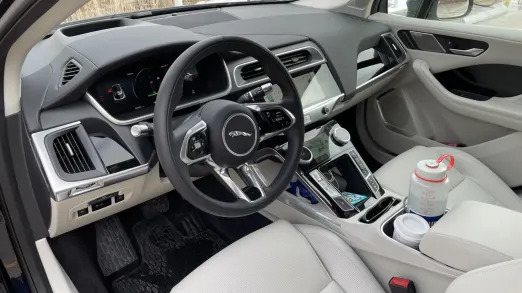
The interior similarly provides an elevated experience, lending itself splendidly to road tripping and daily comfort. Jaguar makes its climate and seat controls a little too complicated for its own good with the auxiliary touchscreen and push/pull knobs, but that’s the worst of my complaints. There are oodles of places to set personal belongings, the seats stay comfortable for hours on end, and wind noise is sufficiently silenced. Tire roar from the winter rubber fitted to the test car is the most intrusive of noises, and while we’re on the topic of tires, I’ll point out that this winter rubber is surely not as ideal for maximum road trip range as the stock all-season tires are.
But! I am mighty glad to have winter tires fitted, because shortly after getting on the road for the trip back to Michigan, it started to snow. Of course, this also meant that the temperature was way down versus the trip to Buffalo (now in the low-to-mid 20s), and it’s likely the cause of all my problems to come.
I start, once again, under the most ideal of circumstances with a 100% charge thanks to being able to plug into a free Level 2 ChargePoint charger overnight that is only a couple blocks away from where I’m staying. Unfortunately, the cold weather is deeply affecting range at this point. After spending an hour on the road driving 70 mph, I quickly come to the realization that there’s no way I can make it the full 175 miles to my first planned charge stop. Even after I completely shut down the climate control system, the predicted range still has me 25 miles short, and it’s falling off quick.
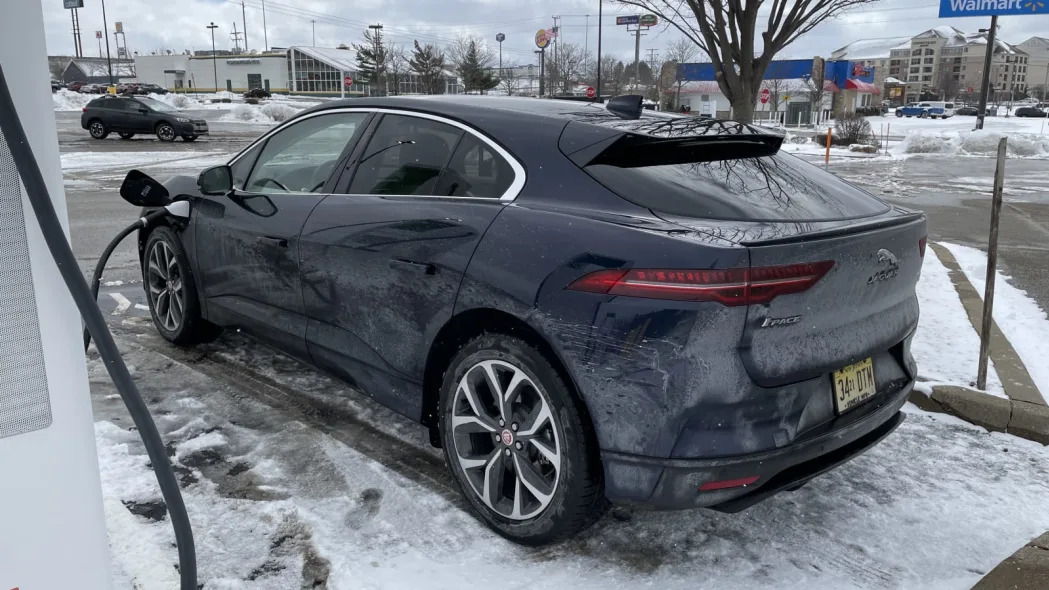
In order to make it, I pull off at the same Electrify America station in Erie that treated me well previously. This time, it’s much less pleasant. Charging speeds peak at about 60 kW when I’m in the 30-40% state of charge range, and it only goes down from there. I spend 22 minutes gathering 16% worth of charge, and that’s just enough to get me to my ultimate dinner destination east of Cleveland. It’s hard to say what the problem was for such slow charging, but either weather or a bad charger are to blame.
My bad luck continues at the next charger just 76 miles down the road. I pull in with just 13% charge left, and once again, this charger peaks around 60 kW charge speed despite a maximum rating of 350 kW, and way off the 100-kW speed the I-Pace is rated for. I spend 1 hour and 18 minutes waiting around here, and leave with a 79% charge, paying $29.84.
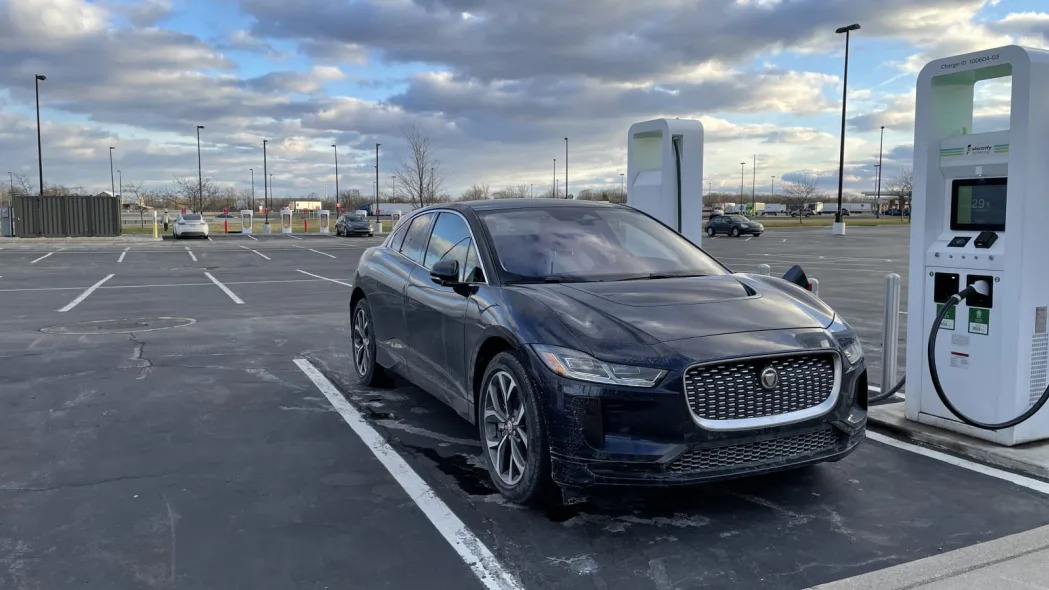
By the time I reached my final charging destination, the temperature had risen to 32 degrees, and was continuing to creep upwards. Upon plugging in at 15% charge, the charging speed jumped right up to 100 kW. I was astonished. It only took 37 minutes to go from 15-70% charge, which is remarkably quick compared to the day I’d been having so far. Once again, it was not cheap at $24.79. This got me home to Detroit, and I finished with a rather unpleasant final trip time of 8.5 hours.
This abysmally long trip was the combined result of driving slowly on the highway to maximize efficiency, the cold weather forcing three charging stops instead of two and slow Electrify America chargers. It wasn’t just a time penalty I faced, but a financial one, too. Total charging costs for my whole weekend totaled $143.51, which is considerably more than the $110 I paid in premium fuel to do the same trip in our long-term BMW 330e. It’s also important to note that I started each way with a 100% charge gained without paying a penny.
If the road trip is short, the I-Pace is a lovely companion, but multi-stop trips are annoying at best. EVs with bountiful range, better efficiency and quicker charging can help you combat the effects of cold weather that the I-Pace fell victim to. If you’re looking for an electric car to use as a daily driver around town, the I-Pace is still a completely valid option. Its concept car looks are as alien as ever; there’s never a dull driving moment, and the cabin’s quality matches my tester’s $73,095 asking price. If you’re not after Jaguar luxury, though, options like the Kia EV6, Hyundai Ioniq 5 and Ford Mustang Mach-E all offer superior charging/electric technology in the form of range and charge speed.
Related video:










Sign in to post
Please sign in to leave a comment.
Continue